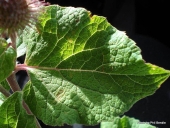I have used Yarrow on many occasions, it is one of my favorite go to herbs to manage fever, as yarrow will adapt to what is needed in the body. In cases where an even low grade fever or raising of body temperature is needed it is most helpful as it will raise the body temperature (this makes it VERY useful in folks who are always cold) and in high fevers it can be used to break the fever as it is diaphoretic (Makes you sweat). Dosage for an infusion is 1tsp to 1 cup boiling water, let steep for 15 minutes and drink. I am attaching a simple herbal monograph for those who want more info:
Achillea millefolium
Common Name: Yarrow
Parts Used: Arial parts -dried and harvested when flowering)
Actions: Nervous System relaxant, anti-pyretic, antiseptic, antibacterial, antimicrobial, anti-inflammatory, astringent, diaphoretic, anti-hemorrhagic, hemostatic, hypotensive, peripheral vasodilator, bitter tonic, choleretic, carminative, hepatic, emmenagogue, diuretic vulnerary.
Uses:
- Thrombotic conditions with raised blood pressure (lowers blood pressure)
- Fevers
- Sore Throat
- Topically as an eye wash for eye inflammations and irritations (make a tea and let it cool, soak cotton balls and set gently on top of the eye)
- Colds, Flu
- Dilates the peripheral circulatory system (aka, allows heat to flow more evenly in the body by improving circulation)
- Internal and External bleeding
- High blood pressure
- Varicose Veins
- Hemorrhoids (can be used as a direct compress - make a tea, let cool to a comfortable temperature, soak a clean cloth or cotton, apply directly to the site, get comfy for 30 min to an hour 3x daily or as needed)
- Digestive tonic - stimulates the appetite
- Diarrhea
- Regulates/normalizes duration of the menstrual cycle
- Topically for healing wounds, infections, bruises, swellings, and strains
Tincture Ratios and Dosage (for internal/oral application - do NOT put a tincture on your hemorrhoids

)
- 1 part herb to 1 part 25% alcohol - 2 to 4ml 3 times daily
- 1 part herb to 2 part 45% alcohol - 2 to 6ml daily (once!)
- 1 part herb to 5 parts 45% alcohol - 2 to 4 ml 3 times daily
Additional Applications:
- Fresh Juice (Can be taken orally or applied topically)
- Poultice
- Bath (Handful of dried herb to 500ml of boiling water, steep for 15 minutes then pour strained water into bath - do not leave the herb with you in the bath unless you wish to become a sweating, hot, and slightly cranky person)
As a precaution: I am not a doctor, this information is not meant to treat or diagnose. I am a student of medical herbalism sharing the information I have from notes and findings within my own Materia Medica.
-Nicey <3



 )
)


